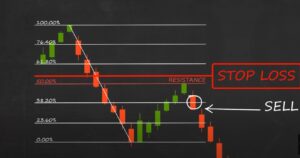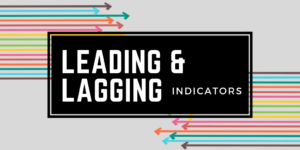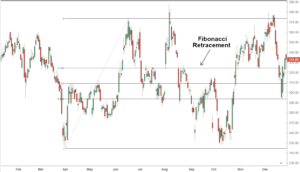The foreign exchange market, or forex for short, is a dynamic landscape where currencies constantly fluctuate in value against each other. For traders navigating this ever-shifting terrain, understanding the rate of change (ROC) becomes a vital tool. This concept goes beyond simply identifying price movements; it delves into the momentum behind those changes, offering valuable insights into potential trend strength and reversals.
Deconstructing the Rate of Change
At its core, the ROC measures the percentage difference between a currency pair’s current price and its price at a specific point in the past. Imagine you’re tracking the EUR/USD exchange rate. The ROC for a 14-period setting would compare the current price to the price 14 periods (days, hours, etc.) ago. The calculation is expressed as:
ROC = (Current Price - Price X Periods Ago) / Price X Periods Ago x 100
This formula yields a percentage value. A positive ROC indicates the current price is higher than the price X periods ago, suggesting an upward momentum. Conversely, a negative ROC signifies a price decline compared to the past period, reflecting downward momentum.
The ROC as a Momentum Indicator
The ROC shines as a momentum indicator. Momentum refers to the speed and intensity behind a price movement. A strong upward trend will typically be accompanied by a rising ROC, indicating accelerating buying pressure. Conversely, a falling ROC in a downtrend suggests the selling pressure might be weakening, potentially signaling a trend reversal.
Visualizing the ROC: The Rate of Change Indicator
Most forex trading platforms offer a dedicated Rate of Change (ROC) indicator. This tool visually represents the ROC calculations over time, typically plotted as a line oscillating around a zero line. When the ROC line is above zero, it suggests upward momentum, while values below zero indicate downward momentum.
Interpreting the ROC Signals
While the ROC provides valuable insights, it’s crucial to interpret its signals within context. Here are some key considerations:
- Overbought and Oversold Levels: The ROC doesn’t have predefined boundaries. However, some traders use thresholds like +20% or -20% as potential indications of overbought or oversold conditions. A persistently high ROC might suggest the currency pair is due for a correction, while a very low ROC could hint at a potential reversal. It’s essential to remember these are just guidelines, not foolproof signals.
- Confirmation with Other Indicators: The ROC is most effective when used in conjunction with other technical analysis tools. For example, combining it with trend indicators like moving averages can help strengthen confirmation of potential trend continuations or reversals.
Beyond the Basics: Advanced ROC Applications
While the core principles remain the same, some advanced applications of the ROC can enhance your forex trading strategies:
- Rate of Change of ROC (ROCR): This indicator measures the rate of change of the ROC itself, highlighting shifts in momentum. A rising ROC suggests accelerating momentum, while a falling ROC indicates weakening momentum.
- Average True Range (ATR) with ROC: The ATR gauges market volatility. By overlaying the ROC on the ATR, traders can assess if the ROC signals are occurring during high or low volatility periods. This can help differentiate genuine momentum shifts from noise caused by volatile market swings.
Limitations of the ROC
The ROC, like any technical indicator, has limitations:
- False Signals: The ROC can generate false signals, particularly during ranging markets or periods of high volatility. Combining it with other indicators helps mitigate these false positives.
- Lagging Indicator: The ROC is a lagging indicator, meaning it reacts to past price movements. While it can identify momentum shifts, it doesn’t predict future price movements.
Incorporating the ROC into Your Forex Trading Strategy
Here’s how you can leverage the ROC in your forex trading strategy:
- Identify Momentum: Use the ROC to gauge the strength of a trend. A rising ROC during an uptrend suggests potential continuation, while a falling ROC might indicate a weakening uptrend or a possible reversal.
- Spot Potential Reversals: When the ROC diverges from the price action, it can signal a potential reversal. For instance, if the price keeps making new highs but the ROC fails to follow suit, it could be a warning sign of an impending downtrend.
- Filter Trades: The ROC can be used as a filter for entry and exit points. For example, you might only consider entering long positions (buying) when the ROC is positive and rising, suggesting strong upward momentum.
The ROC as a Compass in the Forex Market
The Rate of Change serves as a valuable tool in the forex trader’s arsenal. By understanding its core principles, interpreting its signals within context, and incorporating it with other technical analysis tools, you can gain valuable insights into momentum, trend strength, and potential reversals. Remember, the ROC is not a crystal ball, but rather a compass that helps you navigate the ever-changing currents of the forex market. Here are some additional tips for maximizing the effectiveness of the ROC:
- Experiment with Different Timeframes: The effectiveness of the ROC can vary depending on the timeframe used for the calculation. Shorter timeframes (e.g., hourly) might be more suited for scalping strategies, while longer timeframes (e.g., daily or weekly) can be useful for identifying longer-term trends.
- Backtesting with Historical Data: Before deploying the ROC in live trading, consider backtesting its performance with historical data. This allows you to assess its effectiveness with different currency pairs and timeframe settings in various market conditions.
- Practice Discipline and Risk Management: The ROC is a tool, not a guarantee of success. Always prioritize sound risk management practices and maintain discipline in your trading decisions. Don’t chase every signal blindly, and be prepared to adapt your strategy based on market conditions.
By mastering the ROC and integrating it with a comprehensive trading approach, you can enhance your ability to identify profitable opportunities in the dynamic world of forex trading. Remember, consistent learning, experience, and a healthy dose of skepticism are key ingredients for navigating the ever-evolving forex landscape.
Let’s Manage Your Forex Funds With Fx Pips Guru!
Fx Pips Guru is a forex fund management company managing client’s funds based on monthly profit share. Let’s do Live Chat with our experts.




